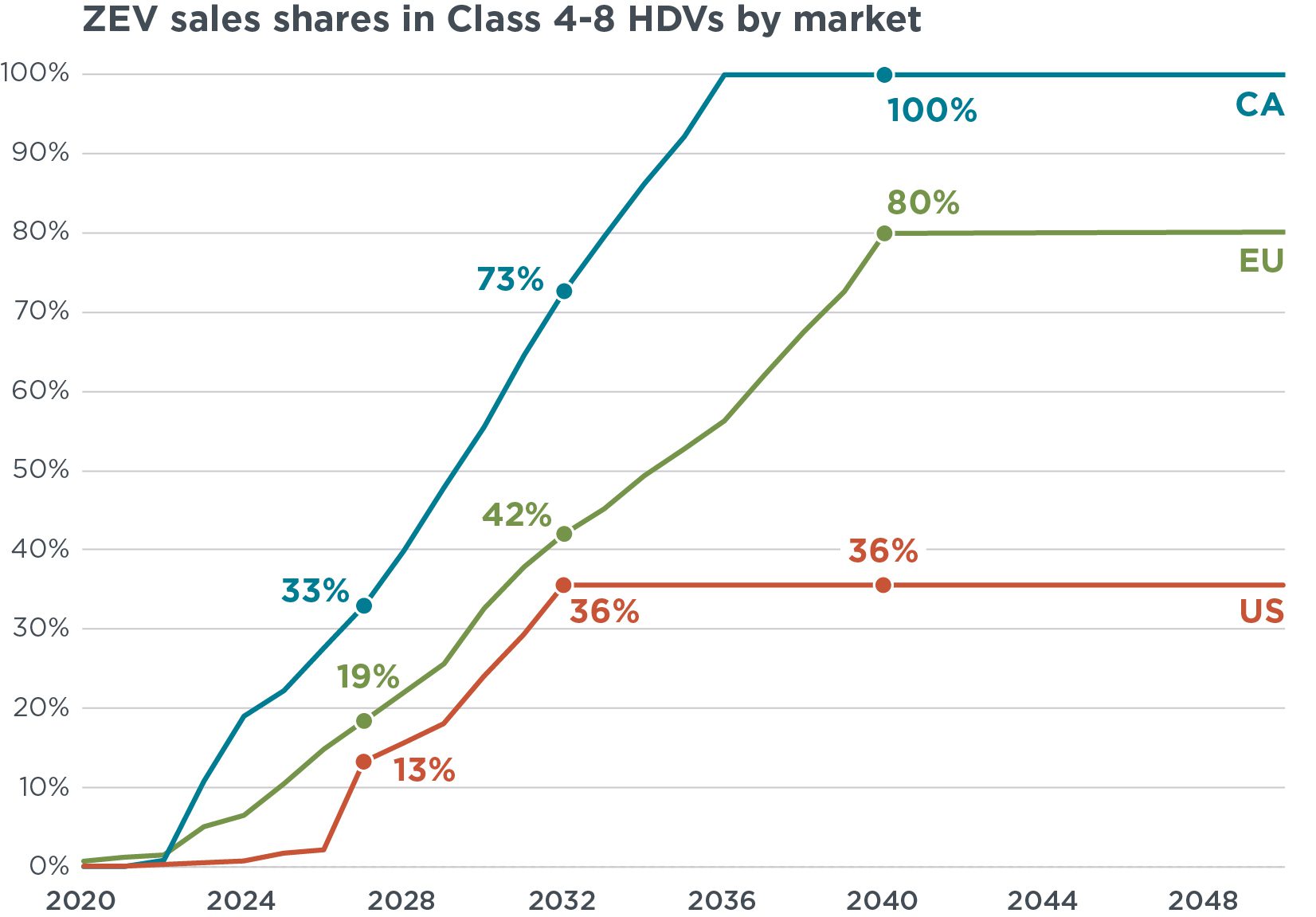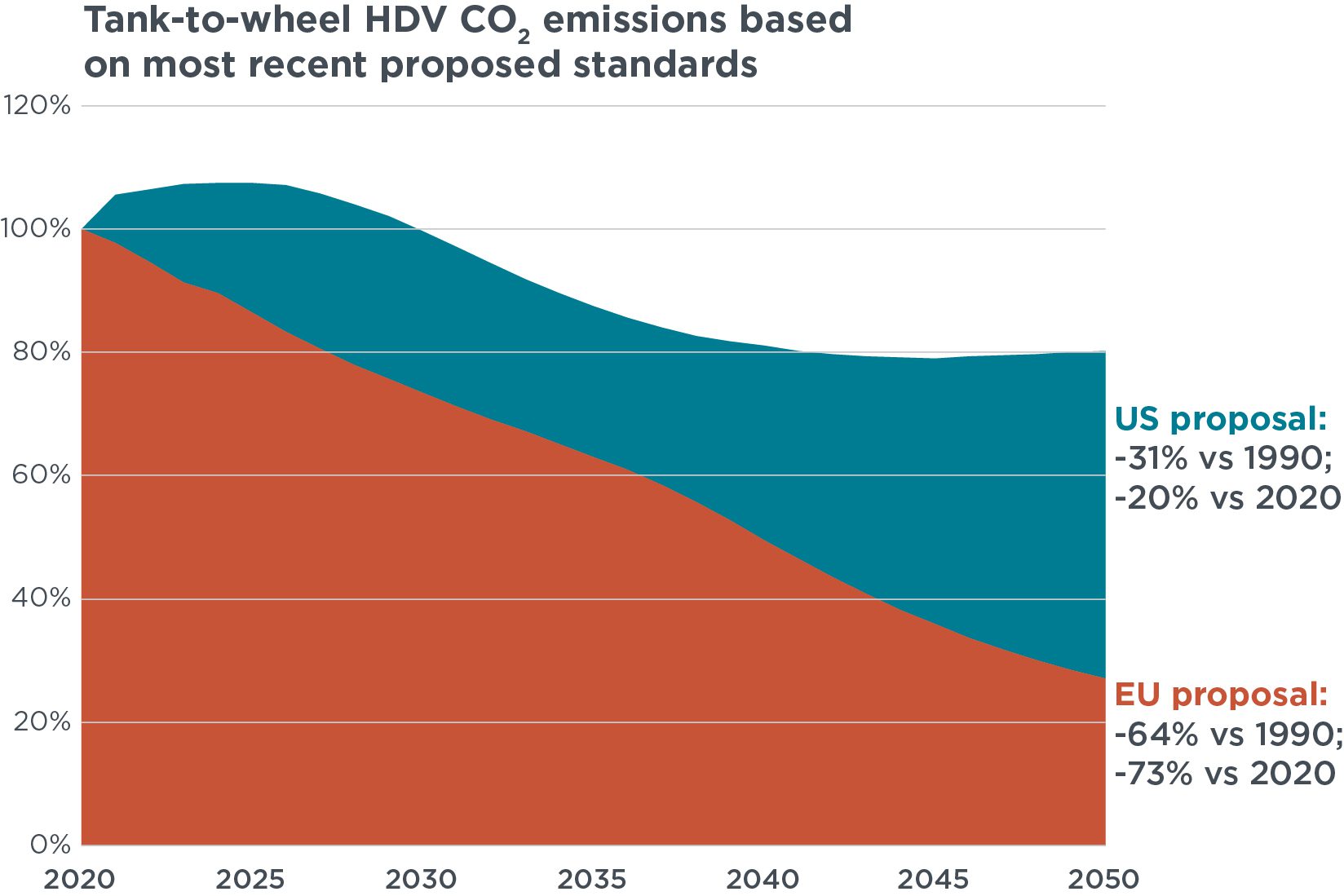Europe’s proposed heavy-duty CO2 standards: Room for improvement
Blog
How U.S. and EU proposals could steer the transition to zero-emission truck and bus fleets
Proposed new greenhouse gas (GHG) emission standards for heavy-duty vehicles (HDVs) in the United States and European Union mark the first time that manufacturers would need to sell zero-emission trucks and buses to meet the standards. These proposals, from the world’s largest commercial vehicle market (the United States) and the third largest (the European Union), send a clear policy signal to commercial freight markets around the world. But as we’ll explain, the EU proposal sends a far stronger signal, and the U.S. proposal could come closer to meeting transport decarbonization goals in a couple of important ways.
The European Union was the first mover in February 2023, when the European Commission proposed revisions to HDV carbon dioxide (CO2) standards that would lower fleet-wide emissions to 64% below 1990 levels by 2050. Though these are deeper cuts in emissions than would result from baseline market trends, they are short of the European Union’s high-level target of a 90% reduction in emissions across all transport sectors by 2050.
Two months later, the U.S. Environmental Protection Agency (EPA) released a proposal for Phase 3 HDV GHG emission standards that would reduce tank-to-wheel CO2 emissions to 31% below 1990 levels by 2050. This would make progress toward U.S. climate goals but would not be expected to achieve the 80%–100% reduction in transportation emissions by 2050 that’s laid out in the national Long-Term Strategy.
Both proposals are performance-based standards. This means they don’t explicitly set a sales number for zero-emission vehicles (ZEVs; the exception is urban buses in the EU proposal). It’s important, then, to compare the magnitude of electrification suggested by the two proposals, and the ZEV shares of new sales in Figure 1 are based on ICCT analysis. (We converted the EU vehicle segmentation, called VECTO classes, to the U.S. HDV class system, which is based on gross vehicle weight rating, for ease of comparison.) The purchase requirements and aggregate ZEV sales required by California’s Innovative Clean Transit (ICT), Advanced Clean Trucks (ACT), and Advanced Clean Fleets (ACF) regulations are shown for comparison.

The GHG emission reductions from the U.S. and EU proposals are illustrated in Figure 2. Both proposals are groundbreaking for the technology transition they would support, but as you can see, their ambition is quite different. Even though EU and U.S. climate goals are similar, the two proposals differ in approach. The EU proposal is top-down: It starts from a GHG reduction goal and sets standards designed to meet it. In contrast, the U.S. EPA proposal is bottom-up: It projects zero-emission vehicle sales and sets standards based on those market trends.

Another difference in ambition is the treatment of internal combustion engine (ICE) vehicle efficiency. The EU standards consider the low-cost ICE efficiency technologies available to manufacturers to meet the standards when setting the stringency level, while the EPA proposal assumes manufacturers will not deploy any new ICE efficiency technologies. A consequence of the EPA’s approach will likely be a combination of lower ZEV sales than the Agency is projecting and more limited adoption of commercially available and cost-effective ICE efficiency technologies.
The EU proposal takes an additional step by requiring a 15% reduction in CO2 emissions from more energy-efficient trailers by 2030 relative to 2025 levels. The EPA adopted trailer standards in 2016, but these were suspended in late 2021 following a lawsuit brought by the Truck Trailer Manufacturers Association. To date, the EPA has not re-proposed trailer standards.
New GHG standards for HDVs in the European Union and the United States have the potential to set the long-term policy direction to decarbonize commercial freight. Though the two markets are served largely by the same vehicle manufacturers, the EU proposal sends a far stronger signal and would make more progress toward achieving EU climate objectives. The strongest policy signal to manufacturers serving both markets would come from closely aligned EU and U.S. rules that achieve their respective transport decarbonization goals. In particular, the EPA can come closer to meeting U.S. transport decarbonization goals by assuming higher ZEV sales projections and deployment of additional ICE efficiency technologies. For manufacturers and infrastructure providers, this would make clear that investments in decarbonization throughout the global market are imperative.
Author
Related Publications

These comments provide data and technical analysis to support EPA in delivering greater absolute benefits from its proposal and ensuring these benefits reach more states.


